CEP – KAS: Sahel Monitoring February 2024

For the first time since reporting started in December 2022, the claims of al-Qaeda’s branch in the Sahel, Jama’a Nusrat ul-Islam wa al-Muslimin (JNIM), are more than double the number of claims by both Islamic State branches. Since October 2023, there has been a significant rise in JNIM’s activity—though al-Qaeda’s attacks never surpassed 60 per month, the number reached in January 2024. Now, in February, it made no less than 85 claims and statements.
The total number of registered attacks decreased slightly since last month, but still stands at 121. As predicted in summer 2023, the total number of claims will likely keep on rising towards a new peak, which can be expected by the end of Ramadan in early April 2024. During the month of February, at least 57 IED attacks were registered, which caused severe human and material losses. This does not bode well for the region. Not only is the sheer number of attacks increasing, but so is their lethality.
Attacks in the Sahel – General Trend
As usual, as the number of claimed events rises, the death toll also increases. The central Sahel seems to be close to a state of utter chaos; something both al-Qaeda and the Islamic State will profit from. Again, as we witnessed in Syria and Iraq a decade ago, the theory of Idarat at-Tawwahush (The Management of Savagery) is being followed. This theory was developed in the early 2000’s by Abu Bakr Naji, an al-Qaeda ideologue. It describes three crucial stages a Jihadi insurgency should attain to reach the goal of establishing an Islamic state..
In stage one al-Nikayawal-Tamkin (“vexation and empowerment”), the “will of the enemy” will be broken through the destruction of “vital economic and strategic targets” ultimately leading to a breakdown of public order. Stage two is the Idarat at-Tawwahush (“administration of savagery”). In the wake of the collapse of general order, the law of the jungle will prevail, and survivors will “accept any organization, regardless of whether it is made up of good or evil people.” Jihadists can take advantage of this savagery to win popular support, or at least acquiescence. According to the theory, Jihadis will be the organization that gains acceptance through enforcing sharia and providing basic services of security, food, and medicine. The areas they control will serve as bases to attack other states that have not yet been overthrown, to “plunder their money, and place them in a constant state of apprehension”.
The final stage is Shawkat al-Tamkin (“empowerment”), when Jihadis will establish an Islamic state, ruled by a single leader who will unify diffuse and scattered groups and regions of "savagery" within a caliphate. Despite the enormous suffering and loss of life caused by the forces of jihad, they will employ a mixture of persuasion and coercion to win hearts and minds and gain legitimacy and recognition for Islamic rule.
It is exactly this theory that both al-Qaeda and the Islamic State seem to be following in their wars throughout the Sahel. The chances of them establishing a “Caliphate” in some form are, however, quite slim since Africa does not carry any specific ideological meaning for these global terrorist movements. The heartland for both al-Qaeda and the Islamic State is the Arab Middle East. The dream of the Caliphate in as-Sham (the Middle East) persists, even though the Islamic State was physically bereft of its territory in Syria after the apocalyptic battle of Baghuz five years ago. Nevertheless, it is clear that both ISIS as well as al-Qaeda are determined to continue their expansion in the Sahel and West Africa, potentially as a base for future operations abroad.
Infographic 1: Jihadi Violence in the Sahel - 2023
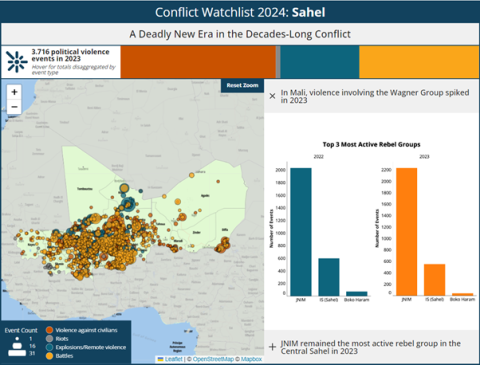
Table 1: Claimed Attacks (December 2022 – January 2024)
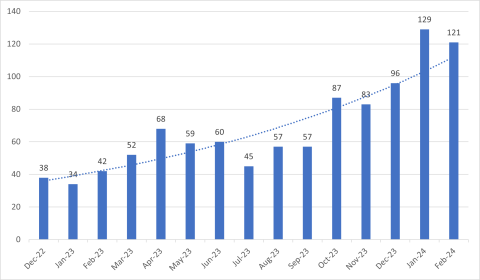
Table 2: Claimed Attacks per Group (December 2022 – January 2024)
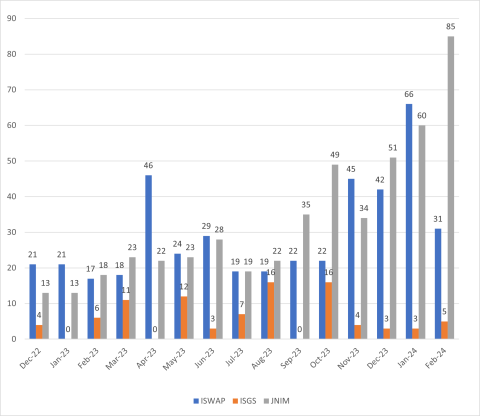
Table 3: Claimed Attacks per Country (December 2022 – January 2024)
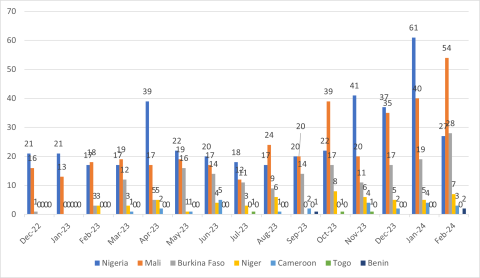
Attacks per Country
- Mali
February saw the highest number of claims in Mali since reporting began in December 2022. On a few occasions in the last months Mali surpassed Nigeria in the total number of claims, but now the number of claims from Mali is twice the number of Nigerian events. Az-Zallaqa Media claimed the majority of events, numbering 50 out of 54. The other claims were posted by Islamic State in the Greater Sahel (ISGS). The targets for both organisations were the same: the Malian Army, loyalist militia, and the Wagner Group/Africa Corps.
Infographic 2: Security Situation in Mali
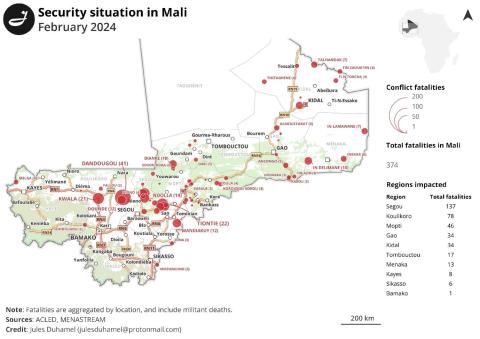
(Source: https://x.com/julesdhl/status/1768619466571571469?s=20)
Picture 1: JNIM Mujahidin Before the Battle with the Malian Army in Ansongo
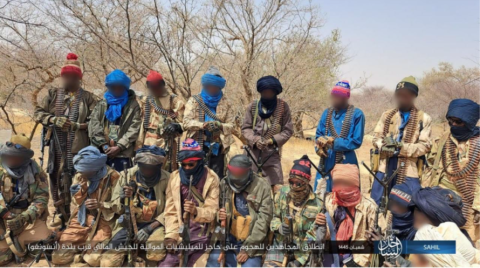
- Burkina Faso
For the first time since reporting started in December 2022, more attacks were claimed in Burkina Faso than in Nigeria. All but one of the 28 claims were attacks on the Burkinabe army claimed by az-Zallaqa Media. On 12 different occasions, JNIM claimed to have detonated no less than 39 IEDs at various targets in Burkina Faso. JNIM reported on a massacre conducted by the Burkinabe regime on the local population in Ouhiguya, causing 223 casualties.
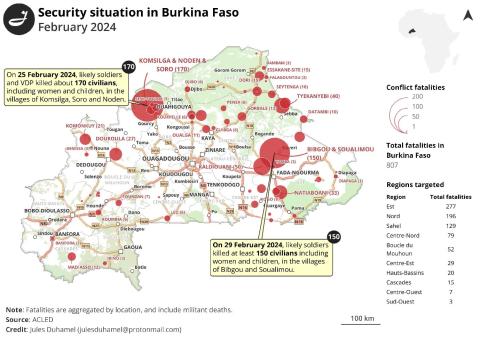
(Source: https://x.com/julesdhl/status/1768270358656733372?s=20)
- Nigeria
For some reason, the Islamic State’s claims from Nigeria dropped from 66 claims in January to merely 27 attacks this month. Some of these attacks were of high impact however, sometimes resulting in a significant number of deaths. Islamic State in Western Africa Province (ISWAP) claimed 11 IED attacks in Nigeria throughout the month.
- Niger
In total, seven claims were published from Niger, four by az-Zallaqa Media, the remaining three by ISGS in Tillabéri and ISWAP in Diffa near the border with Nigeria.
- Cameroon
Two attacks were claimed by ISWAP in Cameroon, killing and wounding around 11 Cameroonian soldiers.
- Benin
Az-Zallaqa Media claimed one attack in two different statements in Benin, near the border with Burkina Faso, again demonstrating how the Jihadi violence is advancing throughout the area.
Table 4: Total number of attacks
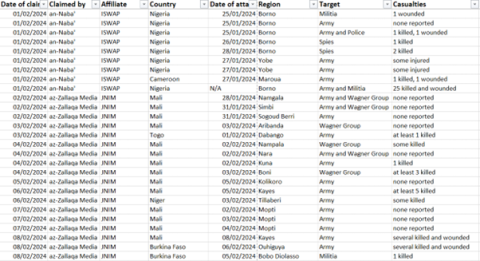
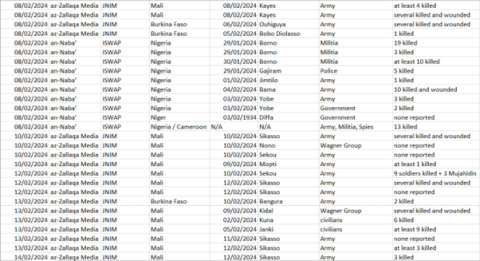
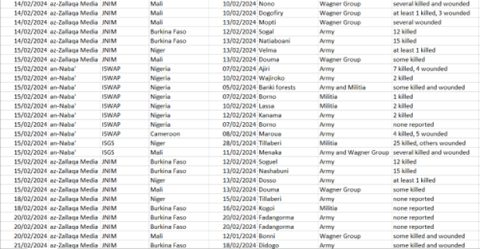
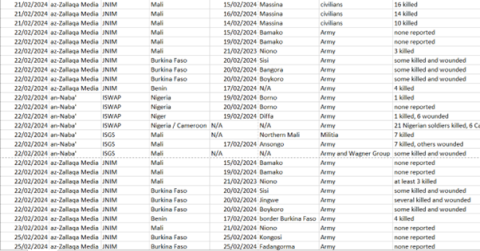

Attacks per Affiliate
JNIM
Again, as has become common, six claims were published accusing the Malian and Burkinabe armies of indiscriminate violence against the local population, killing at least 278 people. The other 79 remaining claims were terrorist operations in Mali (45), Burkina Faso (27), Niger (4), Benin (2), and Togo (1). 46 IED explosions were claimed; one in Niger, four in Mali, and the rest in Burkina Faso. JNIM used a total of 39 IEDs in 12 different attacks, on two occasions ten IEDs were used in a single attack. Again, the Wagner Group/Africa Corps was one of the targets.
Picture 2: Part of the Personal Kit of a Wagner Group Member
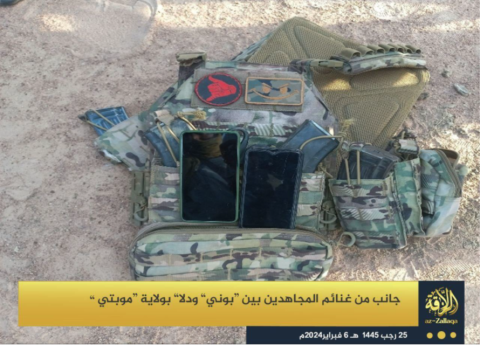
Table 5: Attacks by JNIM
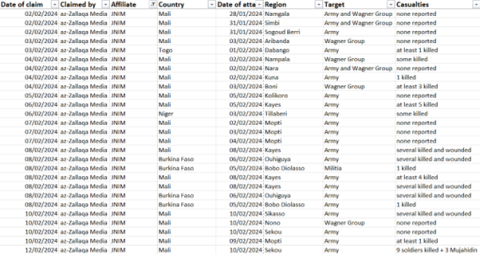
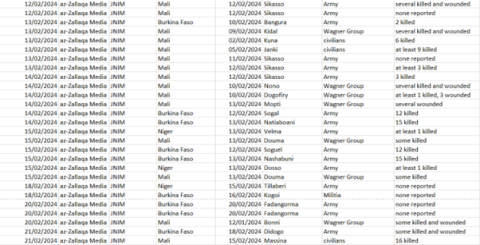
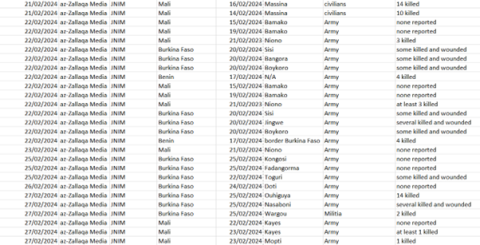

ISWAP
ISWAP claimed merely 31 attacks, more than half the number of claims in January (66). Almost all claims concerned terrorist operations in Nigeria with only a few exceptions. Four attacks were claimed in Cameroon or the Cameroonian-Nigerian border, two in Niger, near Diffa.
11 IED attacks were registered, accounting for some of the most lethal attacks. In one case, 19 loyalist militia members were killed in a single IED attack.
Table 6: Attacks by ISWAP
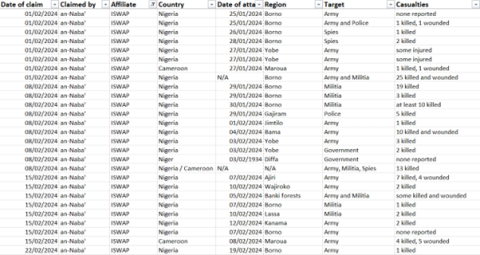

ISGS
Again, as witnessed in all previous reports, ISGS is clearly underreporting on its operations. Only four operations were claimed in Mali and one in Niger. According to ISGS, the Niger attack near Tillabéri was their mostly lethal attack, killing and wounding over 25 militia members.
Table 7: Attacks by ISGS

Conclusion
Although the number of claims by the Islamic State affiliates dropped rather suddenly for unknown reasons, the total number of claimed Jihadi terrorist attacks in the Sahel exceeds 120for the second month in a row. It is clear that both al-Qaeda’s branch and the Islamic State are increasingly targeting Mali and Burkina Faso., Furthermore, it is noteworthy that the number of IED attacks in the region is evidently rising. 57 IED detonations were claimed in Burkina Faso, Mali, Nigeria, and Niger. A total of 10 IED attacks in Nigeria were claimed by ISWAP and 19 different IED operations were claimed by JNIM in Burkina Faso, Mali, and Niger.
For the fifteenth month in a row, we can only conclude that the entire situation is going from bad to worse. In December 2022, when this research started, barely 38 statements were published by al-Qaeda’s JNIM and the Islamic State’s two branches in the Sahel: ISWAP and ISGS. 15 months later there is an increase of claimed Jihadi violence by over 320 percent!
Nonetheless, this burgeoning Islamist terrorist threat in the Sahel is not gaining the attention it deserves in the international media or among key decision makers. Unfortunately, outside the region, this growing terrorist threat remains largely unnoticed, despite it being the most precarious security situation the region has experienced in decades. It is all but certain that this elevated level of terrorist violence will spill over into neighboring countries in the short to medium term. However, it remains to be seen at which point JNIM or the ISIS affiliates in the region might decide to use their increasing financial and human resources, as well as their increasing territorial and natural resource control, against targets in Europe and the West.
Stay up to date on our latest news.
Get the latest news on extremism and counter-extremism delivered to your inbox.